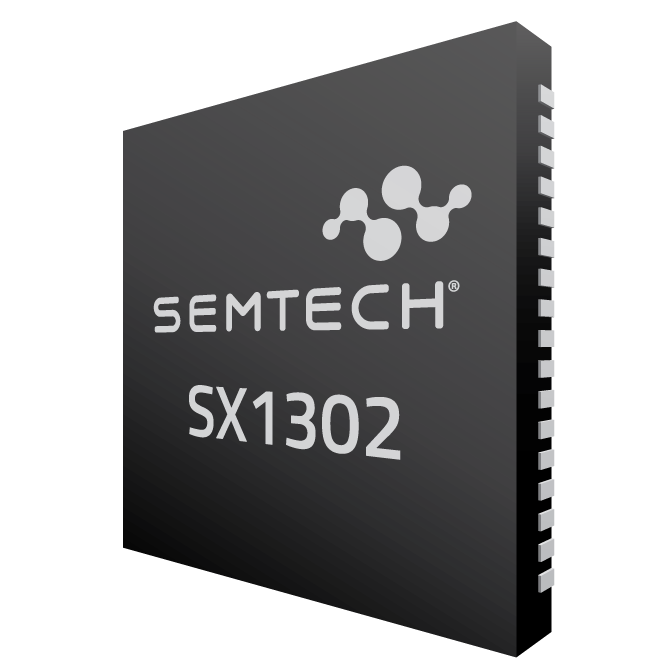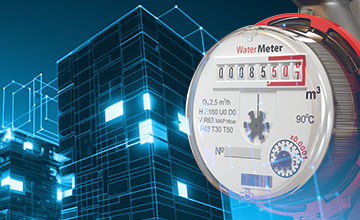| PART NUMBER | PRODUCT STATUS | FREQUENCY RANGE (MHz) | TX/RX | TX POWER (dBm) | DIGITAL BASEBAND COMPATIBILITY | FEATURE |
|---|---|---|---|---|---|---|
| SX1250 | Active | 150 - 960 | Tx/Rx | 22 | SX1302, SX1303 | Half-duplex |
| SX1255 | Active | 400 - 510 | Tx/Rx | -20 to +8 | SX1301, SX1302, SX1303, SX1308 | Full-duplex |
| SX1257 | Active | 860 - 1000 | Tx/Rx | -20 to +8 | SX1301, SX1302, SX1303, SX1308 | Full-duplex |
| SX1258 | Active | 779-787 | n/a | n/a | SX1301, SX1308 | n/a |
| PART NUMBER | PRODUCT STATUS | Generation | # OF MULTI-DR MODEMS | Spreading Factors | FSK Modems | Operational Current (mA) | Sensitivity (dBm) | Fine-Timing | Data Rates | Temp Range (C) |
|---|---|---|---|---|---|---|---|---|---|---|
| SX1302 | New | 2 | 16 | SF5-12 | 1 | 100mA | -141dBm | No | 800-300Kbps | -40 - +85 |
| SX1303 | New | 2 | 16 | SF5-12 | 1 | 100mA | -141dBm | Yes | 800-300Kbps | -40 - +85 |
| SX1301 | NRND | 1 | 8 | SF7-12 | 1 | 100mA | -139dBm | No | 800-300Kbps | -40 - +85 |
| SX1308 | NRND | 1 | 8 | SF7-12 | 1 | 100mA | -139dBm | No | 800-300Kbps | 0 - +70 |
| Part Number | Product Applicability | Region | Type | Description |
|---|---|---|---|---|
| One Channel Hub | SX1261, SX1262, SX1268, LR1121 and LLCC68 | EU, NA, CN | DVK | One-Channel Hub and ESP32 for 868MHz, 915MHz and 470MHz |
| Corecell Gateway | SX1302 | EU, NA, CN | Shield: SX1302CSSXXXGW1, SX1303CTSXXXGW1, SX1302CFDXXXGW1, SX1302CFD915GW1-H | LoRa Core Development Kit, 868MHz, 915MHz, and 470MHz Bands |
| Picocell Gateway | SX1308 | EU, NA | Shield: SX1308P490GW, SX1308P868GW, SX1308P915GW | LoRa Core Development Kit, 868MHz and 915MHz Band with USB |
| 2.4GHz Gateway | SX1280 | Worldwide | Shield: SX1280ZXXXXGW1 | LoRa Core Development Kit, 2.4GHz ISM Band |
| Solution | Status | Product Applicability | Type | Description |
|---|---|---|---|---|
| Sx1302_hal | New | SX1302,SX1303, SX1250 | Packet Forwarder | Corecell UDP packet forwarder and hardware abstraction layer |
| One Channel Hub | New | SX1261, SX1262, SX1268, LR1110, LR1120, LR1121, LLCC68 | Packet Forwarder | One Channel Hub UDP packet forwarder |
| LoRa Basics Station | Active | SX1301, SX1302, SX1250, SX1255, SX1257 | Packet Forwarder | LoRa Basics Secure, Remotely Configurable packet forwarder |
| LoRa_Gateway | NRND | SX1301, SX1257 | Packet Forwarder | SX1301 UDP packet forwarder and hardware abstraction layer for v1.0 and v1.5 reference designs |
Frequently Asked Questions
Each SX1257/50/55 chip can digitize almost 1 MHz of spectrum, therefore two are required typically to achieve 8 channels with a channel separation of 200 kHz or so.
The limitation of using a single SX1257/50/55 chip and one SX1301/08/02 chip is that you can only digitize 1 MHz of spectrum (and not 2 MHz) and can only build a 4 channel modem since the channels are spaced 200 kHz apart.
Additional FAQs
Additional FAQs
A PicoCell Gateway is typically a small, localized device or system used to manage cellular network connections, specifically for the purpose of improving cellular coverage within a specific, limited area, such as a building or a campus. It can be considered part of a femtocell or small cell network, which is a low-power, short-range cellular base station that connects to the internet or a private network to provide improved service in areas where traditional cell towers might not provide adequate coverage.
Key features of a PicoCell Gateway include:
- Local Cellular Coverage: It enhances signal strength in areas with poor network coverage, such as indoor locations or remote areas.
- Internet Backhaul: It connects to the internet via broadband or other backhaul methods to route calls, data, and texts through the larger cellular network.
- Improved Data and Voice Quality: With a PicoCell Gateway, users experience better data speeds, voice clarity, and fewer dropped calls.
- Private Network Support: In some cases, the PicoCell Gateway can provide a private network for a company or home, ensuring more secure communication.
The CoreCell Gateway is a term often associated with advanced telecommunications infrastructure, specifically in the context of 5G and small cell networks. While the exact definition can vary depending on the vendor or context, a CoreCell Gateway generally refers to a key component in the deployment of small cells, providing integration and management between the Radio Access Network (RAN) and the core network.
Key Functions of a CoreCell Gateway:
- Aggregation and Processing: It aggregates data traffic from multiple small cells (like picocells, microcells, or femtocells) and processes it for routing to the core network.
- Network Optimization: Enhances the performance of small cells by optimizing communication, managing interference, and ensuring efficient use of resources.
- Seamless Connectivity: Bridges the small cell environment with the larger cellular network, ensuring uninterrupted service for users.
- Edge Computing Integration: Many CoreCell Gateways integrate edge computing capabilities to process data closer to the user, reducing latency and improving performance for applications like IoT and real-time analytics.
- Backhaul Support: Provides backhaul connectivity (wired or wireless) to the core network, facilitating the transfer of large volumes of data.

















.png)
















